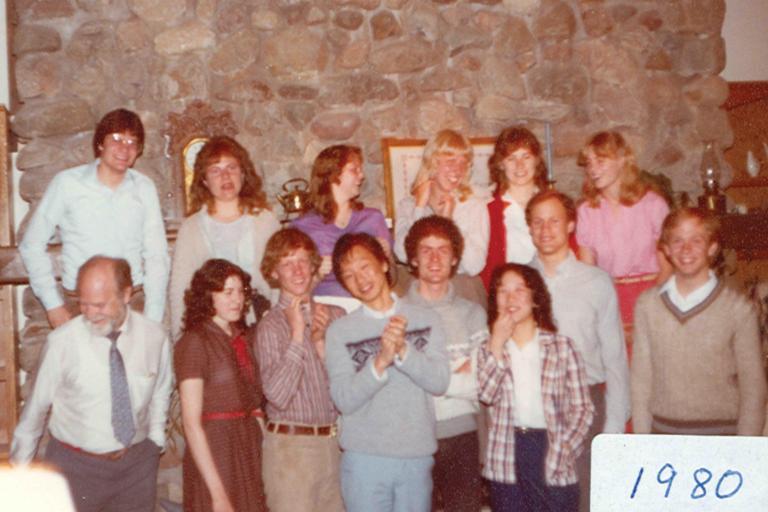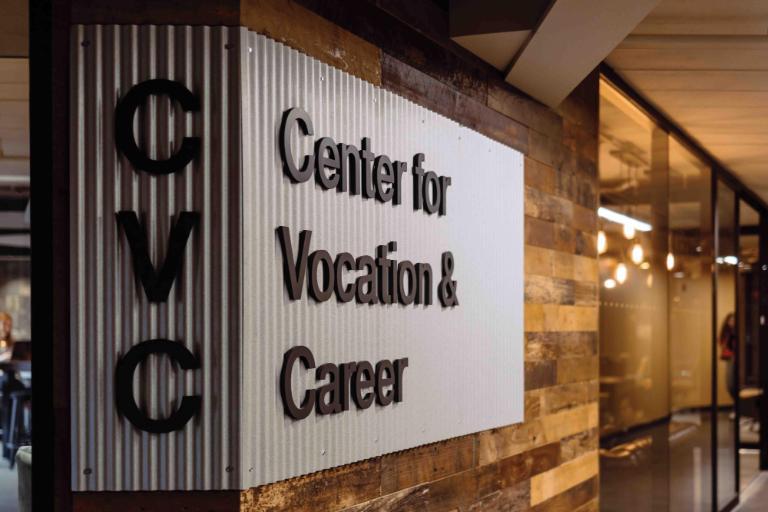We're Still Here: Witness and Evangelism in Post-Christendom
Words: Ciera Horton McElroy ’17
Photos: Katherine Hysmith
The table is set. The candles are lit. Bread, handmade and freshly baked, sits in golden slices on the table. Somewhere, there is music—piano hymns, familiar and holy. There is a quiet shuffle as people take their seats, as they hold hands and whisper the words of prayer, at once poetic and pleading and raw.
The believers eat. They talk and share stories. They participate in the rhythm of public prayer and Scripture reading. It is a portrait of the book of Acts: “Every day they continued to meet together in the temple courts. They broke bread in their homes and ate together with glad and sincere hearts, praising God and enjoying the favor of all the people. And the Lord added to their number daily those who were being saved” (Acts 2:46-47, NIV).
This is a dinner party with liturgy. This is church.
In 2019, Christianity Today published an online article entitled, “Why Are Some Churches Trading Pews for Dinner Tables?” The answer? People were hungry for community, for churches where they could be together and minister “to the whole person in tangible ways.” It was an accessible and authentic form of evangelism—a way to welcome unchurched people to the table.
And then COVID-19 happened.
Across the country, churches closed their doors. We exchanged church socials for social distancing. People went home. They slept in on Sundays and oriented themselves around a new way of life and worship. Pastors preached before cameras. Dinner churches took to Zoom. “Sunday best” became loungewear for streaming sermons on the couch.
Even before the pandemic, American Christianity was at a point of reckoning. Although there are more denominations than ever—4,700—Christianity has been steadily losing its historic position of power in the West. Misleading headlines and books warned the church was on a steep decline, threatening to die out. For example: In October 2019, Pew Research Center published an article titled, “In U.S., Decline of Christianity Continues at Rapid Pace.” Similarly, as author Rod Dreher wrote in The Benedict Option (Sentinel, 2017), “There are people alive today who may live to see the effective death of Christianity within our civilization.”
Alarmist pundits claimed that secularization would quell the church and that millennials were leaving the faith in record numbers.
“These myths prove self-fulfilling prophecies, discouraging Christians about the future of their faith and making them hesitant to engage their communities with the gospel,” Dr. Ed Stetzer, Executive Director of the Wheaton College Billy Graham Center (BGC), wrote. Stetzer has repeatedly pointed out the “survey fail” among Christians. In other words, Christians are inclined to panic without really understanding the data.
The misunderstanding has severe implications, however. If we believe that evangelism is futile, then why talk about Jesus at all? If we accept click-baiting statistics on the “disappearing church” as fact, then why tether ourselves to a sinking ship?
Dr. Rick Richardson is Director of the BGC Research Institute and the author of You Found Me: New Research on How Unchurched Nones, Millennials, and Irreligious Are Surprisingly Open to Christian Faith (InterVarsity, 2019). The book draws from the BGC’s unparalleled study on 2,000 unchurched people, the majority of whom were open to spiritual conversations. Based on this, Richardson cited Luke 10:2 as a blueprint for the American church: “The harvest is plentiful, but the workers are few. Ask the Lord of the harvest, therefore, to send out workers’’ (NIV).
“As I talk to church leaders around the country,” Richardson wrote, “I often feel like I hear the opposite message: ‘The harvest is sparse, the workers are many, and the competition for the few interested unchurched people is intense. People in our culture just don’t care about the gospel anymore, and they don’t like the church.’”
But is this really true?
As Richardson demonstrates, a nuanced reading of the data shows that there is every reason to be optimistic about the church in America. Faith is alive and well. However, especially in recent years, society has shifted and our influence has dwindled. Christianity is losing its foothold in American culture. And maybe we shouldn’t try to get it back. Maybe we should focus on the things that make us Christians, not the things that made us popular.
POST-CHRISTIAN OR POST-CHRISTENDOM?
Many people mistakenly refer to our era as “post-Christianity,” though that term implies that Christ’s kingdom no longer exists. We are not post-Christian, but perhaps we are post-Christian-influence. In other words, “post-Christendom.”
“Christendom is that situation in society where Christian faith and congregations get preferential treatment, status, and privilege,” Richardson told Wheaton Magazine. “In return, the church legitimizes the government. Post-Christendom is the time when the church is more marginalized and also more distinctive in her identity and witness.”
In the years before Emperor Constantine made Christianity the official religion of the Roman Empire, Christianity was antithetical to worldly gain. Conversion was dangerous. Christ-followers took literally the call to take up their cross and follow Jesus. The persecution of the early church meant that those who called themselves followers of The Way were truly committed and radical believers. They stood to lose everything—their work, their families, their lives—for the resurrected Messiah. And he was worth it.
After Constantine’s conversion in the fourth century, many converted to Christianity because there was now benefit to do so. Enter the “Nominal Christian.” Before the “Chreasters,” or, “Christmas-and-Easter-Onlys,” the church saw widespread growth and conversion as Christianity became the predominant religion in the West. Suddenly, members of the clergy were in positions of power. The pope was a political figure. Christian values became socially normative.
British historian Diarmaid MacCulloch referred to the dawn of Christendom as, quite literally, “the union between Christianity and secular power.”
This is not to paint historic Christendom as the “good old days” of the church. Any idealism of the past is misplaced nostalgia. Christian leaders throughout the centuries often abused their power, from financial manipulation to colonialistic agendas. In other words, this hegemony didn’t necessarily look like kingdom work.
But why the cultural shift away from Christianity’s place of power and prominence? The answer is as complex and nuanced as the church itself, but there are several key contributing factors.
First, and most evidently, the former Christian sovereignties are no more: the Holy Roman Empire, the Byzantine Empire, and the British Empire, to name a few. In their places arose secular and pluralist leadership out of the Enlightenment.
The church itself also evolved on a similar trajectory of secularization. H. Richard Niebuhr, author of the pivotal work Christ and Culture (1951), charted the history of religious growth and decline.
“In his analysis,” said Dr. Richardson, “a key factor is that when movements succeed they become more focused on worldly concerns and they become more like the culture that surrounds them. In that way, their causes become more akin to the cultural causes of the day, and they stop emphasizing evangelism, eternity, and the unique or distinctive characteristics and emphasis of vibrant religious faith. The bottom line: Churches decline because they succeed and become like the culture.”
The result of this assimilation is that the church is less distinct from the broader culture. And when the church is less distinct, it’s automatically less captivating. Thus, we arrive at the modern dilemma.
TO JOIN OR NOT TO JOIN
In the 1950s, it wasn’t uncommon for men to get off work and trade their briefcases for bowling shoes. They joined teams and bowling leagues. They had memberships. Today, the number of people who bowl has increased while the number of groups has decreased. This phenomenon is the central metaphor of Bowling Alone: The Collapse and Revival of American Community (Simon & Schuster, 2000) by Robert D. Putnam. And according to Dr. Timothy Larsen ’89, M.A. ’90, Carolyn and Fred McManis Professor of Christian Thought, this metaphor illustrates a similar phenomenon for Christians: changes in church membership.
“We live in a deeply informal time period,” said Larsen. “It’s become much more countercultural to be a member of anything and to structure your time so that you’re committed to a weekly meeting.”
Especially before the ease of modern transportation, much of a family’s social life orbited around church. The weekly Sunday meeting in the old steepled building was where you found a spouse or learned about town news.
“It was an event,” said Larsen. “What happens over the course of the 20th century is that we find all kinds of ways to be entertained and fulfilled in our free time, which makes church look less appealing. It’s not that people stopped believing in doctrine or Christian thought and therefore stopped going to church. It’s the other way around. They still believe in God but church and the organization has been de-centered.”
This is where the misleading data comes in. According to the Pew Research Center, the number of adults describing themselves as Christians in the United States is down 12 percent in the past decade. This does not mean that 12 percent of born-again believers have walked away from the faith. Instead, this is the demographic of people who historically claimed to be “Christian”—perhaps because of social pressure—and do not anymore. As of 2019, 26 percent of the American population claimed to be atheist, agnostic, or “nothing in particular.” These are the “nones.”
“The word ‘nones’ probably does not mean what you think it means,” Richardson wrote in You Found Me. “They are not necessarily antireligious, anti-Christian, or even antichurch. Many are very spiritual, and more of them than you might expect are receptive to congregations and faith conversations. Nevertheless, it is a startling statistic signifying a stunning trend in American society. Churches and congregations are losing their influence and social status for an increasing percentage of Americans, particularly where there are the most consequences for congregations of the future—that is, among emerging adults.”
Perhaps a better way of thinking about our current climate is that church has lost its appeal even more than faith itself.
THE CLARITY OF CONVICTION
What does all of this mean for the church post-Christendom and post-COVID?
Larsen stated it clearly: “The church is free to really be the church.”
In the absence of worldly gain and political capital, the church is again made distinctive by true gospel convictions. We give to Caesar what is Caesar’s. First John 2:15-17 is very clear: “Do not love the world or the things in the world. If anyone loves the world, the love of the Father is not in him. For all that is in the world—the desires of the flesh and the desires of the eyes and pride in possessions—is not from the Father but is from the world. And the world is passing away along with its desires, but whoever does the will of God abides forever” (ESV).
As nominal Christians distance themselves from their religiosity, what’s left is a church of those who really want to be there and who really believe. Orthodoxy is, again, central to a Christian identity. This is a necessary refining as we untangle the faith from where it got caught in the weeds of politics and polarization.
As for evangelism and mission, Stetzer anticipates the future to be “more scattered, less gathered.” Our culture’s loss of respect and trust in religious institutions is not likely to change anytime soon. Still, the people of God have every opportunity to be a light in their work, neighborhoods, and local contexts. “There will be more gospel-sharing with people in relationships and fewer unchurched people showing up on Sunday morning,” he says.
This is necessarily distinct from the evangelistic crusades of the last century.
“The Billy Graham gospel was nice,” said Dr. David Fitch ’77, B. R. Lindner Chair of Evangelical Theology at Northern Seminary. “Appealing. Calling people into a more personal faith out of their bland Protestantism in the 1950s. But that background doesn’t exist anymore.”
Gone are the days of mass altar calls in stadiums or revival tents. Evangelism post-Christendom may look less like handing out tracts and more like digital evangelism, putting the “social” back in social media to provide fellowship. It may look like providing for people’s physical needs—such as social justice outreach—as well as their spiritual ones. It may look like breaking bread together.
This is not without its challenges. With our dwindling influence in the public sphere has come a disrespect—a derision, even—for many aspects of the Christian tradition and ethic. The church is not blameless here, and we must continue to repent for the ways that pride, racism, sexism, celebrity culture, and many other evils have hurt others and damaged our witness. “Unchurched people feel that Christians tend to be judgmental and therefore not the conversation partner around spiritual things that unchurched people would want,” observed Richardson. Our witness is most effective, therefore, when we find ways to engage in deep relationships and affirm someone in their search for truth.
“This is also a time when ethnic minority churches, churches ministering to populations that have suffered . . . have unparalleled opportunities for vibrancy and growth,” Richardson added. “Our best evangelists will come out of churches that have suffered poverty or oppression or pain. This post-Christendom time will be a time of great impact and influence and expansion for churches that know what it is to have suffered.”
It is from suffering—as Paul showed us time and time again throughout the Epistles—that the gospel message thrives. It is from weakness, not power. From washing feet and breaking bread. Ours is a faith of servanthood, not wealth and coercion or, even, a moral majority.
As James 1:27 tells us, “Religion that God our Father accepts as pure and faultless is this: to look after orphans and widows in their distress and to keep oneself from being polluted by the world” (NIV).
For Wheaton alumna Kendall Vanderslice ’13, author of We Will Feast: Rethinking Dinner, Worship, and the Community of God (Eerdmans, 2019), this is where dinner church succeeds. Based on the early church’s mode of outreach, dinner churches focus on providing an intimate community. After all, you’re more likely to talk to a stranger beside you at dinner than beside you in a pew. This focus on embodiment has made dinner church a popular evangelistic outreach.
“When you build your church around the table,” she said, “people who are physically hungry as well as spiritually hungry are drawn in.”
But dinner church is far from the only movement seeking to answer the question: “What is church?” The faith is flourishing in missional churches, house churches, church-planting networks, and microchurches, among others.
Especially after a year of online communication and social distancing, people ache for real community and authentic relationships with fellow believers. We need the Good News in this country. Now is the time for the church to really be the church.
“Everyone’s got to find a place to be among the hurting, the broken, the marginalized,” Fitch said. “Go and sit at the table. Eat what’s set before you. Be there. Listen.” The harvest is plentiful, and the people are hungry. So, church, are you ready? Will you feed them?





